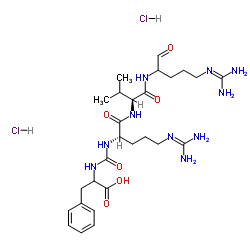37682-72-7
| Name | Antipain dihydrochloride |
|---|---|
| Synonyms |
L-Valinamide, N-[[(1-carboxy-2-phenylethyl)amino]carbonyl]-N-(diaminomethylene)-L-ornithyl-N-[4-[(diaminomethylene)amino]-1-formylbutyl]-, hydrochloride (1:2)
N-[(1-Carboxy-2-phenylethyl)carbamoyl]-L-arginyl-N-(5-carbamimidamido-1-oxopentan-2-yl)-L-valinamide dihydrochloride MFCD00135957 antipain, dihydrochloride N-[(1-Carboxy-2-phenylethyl)carbamoyl]-N-(diaminomethylene)-L-ornithyl-N-{5-[(diaminomethylene)amino]-1-oxo-2-pentanyl}-L-valinamide dihydrochloride L-valinamide, N-[[(1-carboxy-2-phenylethyl)amino]carbonyl]-L-arginyl-N-[4-[(aminoiminomethyl)amino]-1-formylbutyl]-, hydrochloride (1:2) Antipain |
| Description | Antipain dihydrochloride is a protease inhibitor isolated from Actinomycetes. Antipain dihydrochloride inhibits N-methyl-N'-nitro-N-nitrosoguanidine (MNNG)-induced transformation and increases chromosomal aberrations. Antipain dihydrochloride restricts uterine DNA synthesis and function in mice[1][2][3][4]. |
|---|---|
| Related Catalog | |
| In Vivo | The intact, cycling female mice received subcutaneous injections of Antipain dihydrochloride (3 mg) for 16 days, their uteri shows significant diminution in weight and total DNA when compared to untreated controls[4]. Antipain dihydrochloride (100 μg/g body wt; i.p.; at 12h intervals from 0 to 120 h or 240 to 360 h) shows inhibitory effect on Urethane-induced lung neoplasia in mice[5]. |
| References |
| Molecular Formula | C27H46Cl2N10O6 |
|---|---|
| Molecular Weight | 677.623 |
| Exact Mass | 676.297913 |
| PSA | 277.50000 |
| LogP | 4.25060 |
| Storage condition | 20°C |
CHEMICAL IDENTIFICATION
HEALTH HAZARD DATAACUTE TOXICITY DATA
|
| Personal Protective Equipment | Eyeshields;Gloves;type N95 (US);type P1 (EN143) respirator filter |
|---|---|
| Safety Phrases | 22-24/25 |
| RIDADR | NONH for all modes of transport |
| RTECS | YV9350800 |
